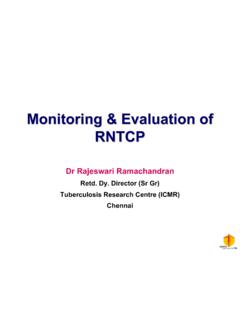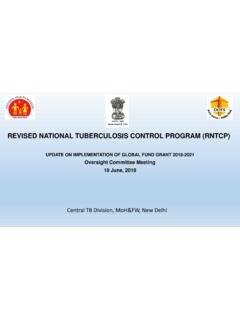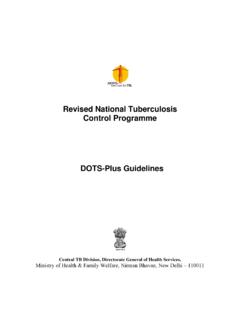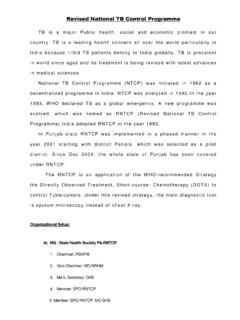Transcription of FEDERAL MINISTRY OF HEALTH NIGERIA - WHO
1 1 FEDERAL MINISTRY OF HEALTH NIGERIA DEPARTMENT OF PUBLIC HEALTH NNNAAATTTIIIOOONNNAAALLL TTTUUUBBBEEERRRCCCUUULLLOOOSSSIIISSS AAANNNDDD LLLEEEPPPRRROOOSSSYYY CCCOOONNNTTTRRROOOLLL PPPRRROOOGGGRRRAAAMMMMMMEEE (((NNNTTTBBBLLLCCCPPP))) WORKERS MANUAL revised 5TH EDITION 2 Adamu, I. Adelusi, A. Adesigbin, O. Agborubere, D. Alabi, G. A. Aribisala, P. Awe, A. O. Balogun. O. Belel, A. D. Chukwu, J. N. Chukwueme, N. C Chukwuekezie, C. Dahiru, T. Dalhatu, A. Ebenso, J. Elom, E Eneogu R, Gebi, U. Gidado, M. Gilgen, K. Huji, J. Jimoh I K. Labaran, S. Liman, Mshelia, L. Namadi A. U Obasanya, O. Ogbeiwi, O. Ogiri, S. Ojika, G. Okpapi, P. Omoniyi, A. Osho, J. A. Otohabru, B Oyenuga, O. Patrobas, P. Stephen, J. Tubi, A. Zuntu, A. 3 EDITORIAL TEAM Nwobi, B.
2 Kabir, M. Obasanya, O. Ogbeiwi, O. 4 FOREWORD tuberculosis and Leprosy are ancient diseases that (unfortunately) still constitute major public HEALTH problems in NIGERIA . In addition, the social stigma associated with these diseases further compounds the problem. It has been estimated that about 460,000 new TB cases and 5,000 leprosy cases occur yearly. In the last five years, there has been significant reduction in the registered prevalence of leprosy with some evidence of reduced transmission. This has been attributed to increased and sustained controlled activities resulting in the elimination of the disease as a public HEALTH problem at national level in NIGERIA . However, there are still endemic pockets at the sub- national level. The greatest challenge in leprosy control remains rehabilitation of a large number of ex-leprosy patients who have been cured of leprosy but have disabilities.
3 While the elimination target for Leprosy has been achieved nationally, progress toward the achievement global targets for TB control remains slow. The control and prevention of tuberculosis in contemporary times has many faces and challenges. These among others include the impact of HIV/AIDS and the emergence of multi-drug resistant tuberculosis (MDR-TB). The HIV/AIDS pandemic is not only fuelling the burden of tuberculosis but also poses great challenge to its diagnosis and management. The recorded HIV prevalence among TB cases in NIGERIA is estimated at 27% (WHO, 2009). Apart from the HIV/AIDS situation, the emergence of MDR-TB not only presents additional burden to the control of TB but is capable of obliterating all the gains of TB control over the years. Although the current burden is currently unknown, the WHO estimates MDR-TB rates of of the new TB cases and among re-treatment cases.
4 Institution-based reported from 2006 to September 2009 showed that 97 MDR-TB cases have been notified so far in the country. This is certainly a tip of the ice-berg and it is hoped that the on-going TB drug drug resistance survey (DRS) will establish exactness in the burden of MDR-TB. In response to the TB/HIV problem, the NTBLCP is collaborating with partners to scale up the TB/HIV collaborative activities in NIGERIA . The ongoing scale up of ART sites is done in centres with existing DOTS services and it is also the policy of the NTBLCP to ensure that all ART sites have DOTS service. The NTBLCP in collaboration with the national MDR-TB committee is also working relentlessly to institutionalize the programmatic management of MDR-TB including 5 routine surveillance. TB reference laboratories are being etsbalished to enhance access to culture and drug susceptibility testing (DST).
5 Specialized treatment centres are also being etsbalished and treatment services will commence shortly following the approval by the Green Ligh Committee for the procurement of quality-assured second-line anti-TB drugs. Furthermore, to achieve a robust TB control and prevention in the country, the FEDERAL MINISTRY of HEALTH , wholly adopted the global Stop TB control Strategy in 2006. This strategy has further been modified in line with contemporary global realities. The review of the 5th edition of the Workers Manual is essentially to align our control efforts with the current global initiatives and consensus and national realities. It is hoped that this revised 5th edition of the Workers Manual will serve as a very useful tool for all HEALTH workers and HEALTH institutions, both government and private, in providing high quality care for patients with TB, TB/HIV co-infection, Leprosy and Buruli Ulcer.
6 Alhaji Bello Suleiman Honourable Minister of State for HEALTH FEDERAL Republic of NIGERIA April 2010 6 ACKNOWLEDGEMENTS The revised 5th edition of the Workers Manual is an indispensable tool for the effective implementation of the national tuberculosis and Leprosy control Programme (NTBLCP). It contains the technical and operational instructions for all HEALTH workers implementing TB and Leprosy control activities and managing TB, TB/HIV, Leprosy and Buruli Ulcer diseases in NIGERIA . I am informed that due cognisance of contemporary issues and initiatives have been well considered in this review exercise. The enormous task of reviewing of the 5th edition of Workers Manual would not have been successfully completed without the support of experts from different fields working in the programme mentioned in the list of contributors. We are indeed grateful for their assistance.
7 We wish to express our thanks to all development partners for their support of the effective implementation of activities of NTBLCP, including: World HEALTH Organization (WHO), members of the International Federation of Anti-Leprosy Association (ILEP) in NIGERIA , namely The Leprosy Mission NIGERIA (TLMN), Netherlands Leprosy Relief (NLR), German Leprosy and TB Relief Association (GLRA) and the Damien Foundation Belgium (DFB); International Union Against TB and Lung Disease (IUATLD), Canadian International Development Agency (CIDA), Department for International Development (DFID), United States Agency for International Development (USAID), and other Voluntary Organizations. Finally special thanks go to TBCAP, WHO and ILEP for co- financing the production of this revised Workers Manual and their technical support. Linus Awute, mni Permanent Secretary FEDERAL MINISTRY of HEALTH April 2010 7 TABLE OF CONTENTS.
8 Page FOREWORD 2 ACKNOWLEDGEMENTS 3 GLOSSARY OF ABBREVIATIONS 5 CHAPTER 1 General Overview 7 CHAPTER 2 Implementation of TB control Components 14 CHAPTER 3 TB/HIV Co-infection 35 CHAPTER 4 tuberculosis Infection control In HEALTH Care Setting 42 CHAPTER 5 Preventing Drug-Resistant tuberculosis 46 CHAPTER 6 Public-Public-Private Partnerships For Dots (PPP) 48 CHAPTER 7 Community tuberculosis Care (CTBC) 49 CHAPTER 8 Laboratory Services for tuberculosis control 51 CHAPTER 9 Leprosy Component 56 CHAPTER 10 Implementing Buruli Ulcer Disease control Component 89 CHAPTER 11 Management of Drugs and Other Supplies 96 CHAPTER 12 Supervision, Monitoring and Evaluation 99 ANNEX 1: Treatment Regimens - Loose Tablets 104 ANNEX 2: HEALTH Information Systems for TB control 106 ANNEX 3: HEALTH Information Systems for Leprosy control 144 ANNEX 4: Logistics Management Information System (LMIS) 170 ANNEX 5.
9 Indicators of NTBLCP 193 8 GLOSSARY OF ABBREVIATIONS USED IN THIS BOOK Abbreviation Meaning AFB AIDS ART BCC BCG CDC CHEW CHO CIDA CPT Acid-Fast Bacilli Acquired Immune Deficiency Syndrome Anti-Retroviral Therapy Behavioural Change Communication Bacille Calmette-Guerin Centers for Disease control and Prevention Community HEALTH Extension Worker Community HEALTH Officer Canadian International Development Agency Cotrimoxazole Preventive Therapy CTBC DFB DFID Community TB Care Damien Foundation Belgium Department For International Development DOT Directly Observed Treatment DOTS EFZ EPTB EQA 4 FDC Directly Observed Treatment Short Course Efavirenz Extra Pulmonary tuberculosis External Quality Assurance Four Fixed Dose Combination FMOH FEDERAL MINISTRY of HEALTH GFATM GHS GCP GLRA HCT HIV HOD Global Fund to Fight AIDS, tuberculosis and Malaria General HEALTH Services Good Laboratory Practice German Leprosy Relief Association HIV Counselling and Testing Human Immunodeficiency Virus Head Of Department IEC ILEP Information Education and Communication International Federation of Anti-Leprosy Associations IHVN IPT IRIS ISTC IUATLD Institute of Human Virology NIGERIA Isoniazid Preventive Therapy Immune Reconstitution Inflammatory Syndrome International Standard for TB Care International Union Against tuberculosis and Lung Disease LGA LGTBLS Local Government Area Local Government tuberculosis and Leprosy Supervisor MB M&E Multi-Bacillary Monitoring and Evaluation MDR Multi-Drug Resistance 9 MDT Multi-Drug Therapy MO NGO Medical Officer Non-Governmental Organisation NLR NPI Netherlands Leprosy Relief national Programme on Immunization NTBLCP national tuberculosis and
10 Leprosy control Programme PAL PALH PB PHC PLHIV PMTCT PPM PPP PTB QAS RFT SCC SSS ss+ Persons Affected by Leprosy Practical Approach to Lung HEALTH Pauci-Bacillary Primary HEALTH Care Persons Living With HIV/AIDS Prevention of Maternal To Child Transmission Public Private Mix Public-Public-Private Partnership Pulmonary tuberculosis Quality Assurance System Release From Treatment Short Course Chemotherapy Slit Skin Smear Sputum smear positive STBLCO STD State tuberculosis and Leprosy control Officer Sexually Transmitted Diseases SMOH State MINISTRY of HEALTH ST Sensory Test TBL TLMN tuberculosis and Leprosy The Leprosy Mission NIGERIA USAID VA VMT United State Agency for International Development Visual Acuity Voluntary Muscle Test WHO ZN World HEALTH Organisation Ziehl Nielsen 10 CHAPTER 1 GENERAL OVERVIEW INTRODUCTION tuberculosis and Leprosy constitute serious causes of high morbidity and mortality, especially in association with the HIV/AIDS epidemic.



















